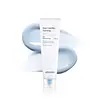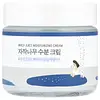What's inside
What's inside
 Key Ingredients
Key Ingredients

 Benefits
Benefits

 Concerns
Concerns

No concerns
 Ingredients Side-by-side
Ingredients Side-by-side

Water
Skin ConditioningGlycerin
HumectantHydrogenated Polydecene
EmollientDipropylene Glycol
HumectantCaprylic/Capric Triglyceride
MaskingMethylpropanediol
SolventGlyceryl Stearate
EmollientPentaerythrityl Tetraethylhexanoate
EmollientVinyldimethicone
Niacinamide
SmoothingCetearyl Alcohol
EmollientHydrogenated Poly(C6-14 Olefin)
EmollientPolyglyceryl-10 Laurate
Skin ConditioningMethyl Trimethicone
Skin ConditioningDicaprylyl Ether
Emollient1,2-Hexanediol
Skin ConditioningSodium Stearoyl Glutamate
CleansingEthoxydiglycol
HumectantC10-18 Triglycerides
EmollientHydroxyethyl Acrylate/Sodium Acryloyldimethyl Taurate Copolymer
Emulsion StabilisingDimethicone/Vinyl Dimethicone Crosspolymer
Skin ConditioningHydroxyacetophenone
AntioxidantGlyceryl Stearates
EmollientJojoba Esters
EmollientAmmonium Acryloyldimethyltaurate/Vp Copolymer
Behenyl Alcohol
EmollientCetyl Alcohol
EmollientStearyl Alcohol
EmollientEthylhexylglycerin
Skin ConditioningXanthan Gum
EmulsifyingPanthenol
Skin ConditioningHelianthus Annuus Seed Wax
Skin ConditioningEclipta Prostrata Leaf Extract
Skin ConditioningLaminaria Japonica Extract
Skin ProtectingOctyldodecanol
EmollientAdenosine
Skin ConditioningAsiaticoside
AntioxidantDisodium EDTA
Hydrogenated Lecithin
EmulsifyingGlycolipids
Skin ConditioningMadecassic Acid
Skin ConditioningAsiatic Acid
Skin ConditioningSorbitan Isostearate
EmulsifyingPolyglyceryl-10 Myristate
Skin ConditioningButylene Glycol
HumectantC12-13 Alketh-9
EmulsifyingFructooligosaccharides
HumectantBeta-Glucan
Skin ConditioningPolyglycerin-3
HumectantMaltodextrin
AbsorbentHydrolyzed Gardenia Florida Extract
AntioxidantDextrin
AbsorbentTheobroma Cacao Seed Extract
AntioxidantHydrolyzed Hyaluronic Acid
HumectantCentella Asiatica Flower/Leaf/Stem Extract
Skin ConditioningCeramide NP
Skin ConditioningLecithin
EmollientTocopherol
AntioxidantAlcohol
AntimicrobialPolysorbate 20
EmulsifyingArginine
MaskingCarbomer
Emulsion StabilisingPhytosphingosine
Skin ConditioningGuaiazulene
AntimicrobialSodium Ascorbyl Phosphate
AntioxidantChamomilla Recutita Flower Oil
MaskingCentella Asiatica Extract
CleansingChamomilla Recutita Flower/Leaf Extract
AntimicrobialFolic Acid
Skin ConditioningSh-Oligopeptide-1
Skin ConditioningSh-Oligopeptide-2
Skin ConditioningSh-Polypeptide-1
Skin ConditioningSh-Polypeptide-11
Sh-Polypeptide-9
Skin ConditioningWater, Glycerin, Hydrogenated Polydecene, Dipropylene Glycol, Caprylic/Capric Triglyceride, Methylpropanediol, Glyceryl Stearate, Pentaerythrityl Tetraethylhexanoate, Vinyldimethicone, Niacinamide, Cetearyl Alcohol, Hydrogenated Poly(C6-14 Olefin), Polyglyceryl-10 Laurate, Methyl Trimethicone, Dicaprylyl Ether, 1,2-Hexanediol, Sodium Stearoyl Glutamate, Ethoxydiglycol, C10-18 Triglycerides, Hydroxyethyl Acrylate/Sodium Acryloyldimethyl Taurate Copolymer, Dimethicone/Vinyl Dimethicone Crosspolymer, Hydroxyacetophenone, Glyceryl Stearates, Jojoba Esters, Ammonium Acryloyldimethyltaurate/Vp Copolymer, Behenyl Alcohol, Cetyl Alcohol, Stearyl Alcohol, Ethylhexylglycerin, Xanthan Gum, Panthenol, Helianthus Annuus Seed Wax, Eclipta Prostrata Leaf Extract, Laminaria Japonica Extract, Octyldodecanol, Adenosine, Asiaticoside, Disodium EDTA, Hydrogenated Lecithin, Glycolipids, Madecassic Acid, Asiatic Acid, Sorbitan Isostearate, Polyglyceryl-10 Myristate, Butylene Glycol, C12-13 Alketh-9, Fructooligosaccharides, Beta-Glucan, Polyglycerin-3, Maltodextrin, Hydrolyzed Gardenia Florida Extract, Dextrin, Theobroma Cacao Seed Extract, Hydrolyzed Hyaluronic Acid, Centella Asiatica Flower/Leaf/Stem Extract, Ceramide NP, Lecithin, Tocopherol, Alcohol, Polysorbate 20, Arginine, Carbomer, Phytosphingosine, Guaiazulene, Sodium Ascorbyl Phosphate, Chamomilla Recutita Flower Oil, Centella Asiatica Extract, Chamomilla Recutita Flower/Leaf Extract, Folic Acid, Sh-Oligopeptide-1, Sh-Oligopeptide-2, Sh-Polypeptide-1, Sh-Polypeptide-11, Sh-Polypeptide-9
Water
Skin ConditioningGlycerin
HumectantIsononyl Isononanoate
EmollientIsododecane
Emollient1,2-Hexanediol
Skin ConditioningPentylene Glycol
Skin ConditioningPolydecene
Skin ConditioningBetula Platyphylla Japonica Juice
Skin ConditioningJojoba Esters
EmollientPanthenol
Skin ConditioningGlyceryl Glucoside
HumectantAcacia Senegal Gum
MaskingHydrolyzed Hibiscus Esculentus Extract
Skin ConditioningSodium Hyaluronate
HumectantHyaluronic Acid
HumectantLupinus Albus Seed Extract
Skin ConditioningMoringa Oleifera Seed Extract
Skin ConditioningMelia Azadirachta Leaf Extract
Skin ConditioningCoccinia Indica Fruit Extract
Skin ConditioningAloe Barbadensis Flower Extract
EmollientSolanum Melongena Fruit Extract
Skin ConditioningOcimum Sanctum Leaf Extract
Skin ConditioningCorallina Officinalis Extract
Skin ConditioningCurcuma Longa Root Extract
MaskingAscorbic Acid
AntioxidantPentaerythrityl Tetraethylhexanoate
EmollientAmmonium Acryloyldimethyltaurate/Vp Copolymer
Polyglyceryl-3 Methylglucose Distearate
EmulsifyingAcrylates/C10-30 Alkyl Acrylate Crosspolymer
Emulsion StabilisingTromethamine
BufferingGlyceryl Acrylate/Acrylic Acid Copolymer
HumectantEthylhexylglycerin
Skin ConditioningAgar
MaskingDipotassium Glycyrrhizate
HumectantGlyceryl Caprylate
EmollientButylene Glycol
HumectantDisodium EDTA
Water, Glycerin, Isononyl Isononanoate, Isododecane, 1,2-Hexanediol, Pentylene Glycol, Polydecene, Betula Platyphylla Japonica Juice, Jojoba Esters, Panthenol, Glyceryl Glucoside, Acacia Senegal Gum, Hydrolyzed Hibiscus Esculentus Extract, Sodium Hyaluronate, Hyaluronic Acid, Lupinus Albus Seed Extract, Moringa Oleifera Seed Extract, Melia Azadirachta Leaf Extract, Coccinia Indica Fruit Extract, Aloe Barbadensis Flower Extract, Solanum Melongena Fruit Extract, Ocimum Sanctum Leaf Extract, Corallina Officinalis Extract, Curcuma Longa Root Extract, Ascorbic Acid, Pentaerythrityl Tetraethylhexanoate, Ammonium Acryloyldimethyltaurate/Vp Copolymer, Polyglyceryl-3 Methylglucose Distearate, Acrylates/C10-30 Alkyl Acrylate Crosspolymer, Tromethamine, Glyceryl Acrylate/Acrylic Acid Copolymer, Ethylhexylglycerin, Agar, Dipotassium Glycyrrhizate, Glyceryl Caprylate, Butylene Glycol, Disodium EDTA
 Reviews
Reviews

Ingredients Explained
These ingredients are found in both products.
Ingredients higher up in an ingredient list are typically present in a larger amount.
1,2-Hexanediol is a synthetic liquid and another multi-functional powerhouse.
It is a:
- Humectant, drawing moisture into the skin
- Emollient, helping to soften skin
- Solvent, dispersing and stabilizing formulas
- Preservative booster, enhancing the antimicrobial activity of other preservatives
Ammonium Acryloyldimethyltaurate/Vp Copolymer (let's call it AAVC for short) is a synthetically created polymer. It's used as a film-forming agent and used to thicken the consistency of products.
AAVC is able to increase the consistency and viscosity of products due to its large molecule size. It also prevents ingredients from separating.
Butylene Glycol (or BG) is used within cosmetic products for a few different reasons:
Overall, Butylene Glycol is a safe and well-rounded ingredient that works well with other ingredients.
Though this ingredient works well with most skin types, some people with sensitive skin may experience a reaction such as allergic rashes, closed comedones, or itchiness.
Learn more about Butylene GlycolDisodium EDTA plays a role in making products more stable by aiding other preservatives.
It is a chelating agent, meaning it neutralizes metal ions that may be found in a product.
Disodium EDTA is a salt of edetic acid and is found to be safe in cosmetic ingredients.
Learn more about Disodium EDTAEthylhexylglycerin (we can't pronounce this either) is commonly used as a preservative and skin softener. It is derived from glyceryl.
You might see Ethylhexylglycerin often paired with other preservatives such as phenoxyethanol. Ethylhexylglycerin has been found to increase the effectiveness of these other preservatives.
Glycerin is already naturally found in your skin. It helps moisturize and protect your skin.
A study from 2016 found glycerin to be more effective as a humectant than AHAs and hyaluronic acid.
As a humectant, it helps the skin stay hydrated by pulling moisture to your skin. The low molecular weight of glycerin allows it to pull moisture into the deeper layers of your skin.
Hydrated skin improves your skin barrier; Your skin barrier helps protect against irritants and bacteria.
Glycerin has also been found to have antimicrobial and antiviral properties. Due to these properties, glycerin is often used in wound and burn treatments.
In cosmetics, glycerin is usually derived from plants such as soybean or palm. However, it can also be sourced from animals, such as tallow or animal fat.
This ingredient is organic, colorless, odorless, and non-toxic.
Glycerin is the name for this ingredient in American English. British English uses Glycerol/Glycerine.
Learn more about GlycerinJojoba Esters is a wax created from Jojoba oil. It is an emollient and film-forming ingredient. In bead form, it is an exfoliator.
This ingredient has high oxidative stability, meaning it doesn't break down when exposed to oxygen.
Its similarity to our skin's natural oils makes it a great emollient. Emollients help soften and soothe our skin by creating a barrier on top. This barrier helps trap moisture in, keeping skin hydrated.
It is created using either the hydrogenation or transesterification processes on jojoba oil.
Learn more about Jojoba EstersPanthenol is a common ingredient that helps hydrate and soothe the skin. It is found naturally in our skin and hair.
There are two forms of panthenol: D and L.
D-panthenol is also known as dexpanthenol. Most cosmetics use dexpanthenol or a mixture of D and L-panthenol.
Panthenol is famous due to its ability to go deeper into the skin's layers. Using this ingredient has numerous pros (and no cons):
Like hyaluronic acid, panthenol is a humectant. Humectants are able to bind and hold large amounts of water to keep skin hydrated.
This ingredient works well for wound healing. It works by increasing tissue in the wound and helps close open wounds.
Once oxidized, panthenol converts to pantothenic acid. Panthothenic acid is found in all living cells.
This ingredient is also referred to as pro-vitamin B5.
Learn more about PanthenolPentaerythrityl Tetraethylhexanoate is an emollient that helps make your skin smooth and hydrated. It specializes in creating a non-oily and "wet" feeling on skin.
This ingredient comes from isostearic acid, a saturated fatty acid. It is a synthetic ingredient.
Water. It's the most common cosmetic ingredient of all. You'll usually see it at the top of ingredient lists, meaning that it makes up the largest part of the product.
So why is it so popular? Water most often acts as a solvent - this means that it helps dissolve other ingredients into the formulation.
You'll also recognize water as that liquid we all need to stay alive. If you see this, drink a glass of water. Stay hydrated!
Learn more about Water